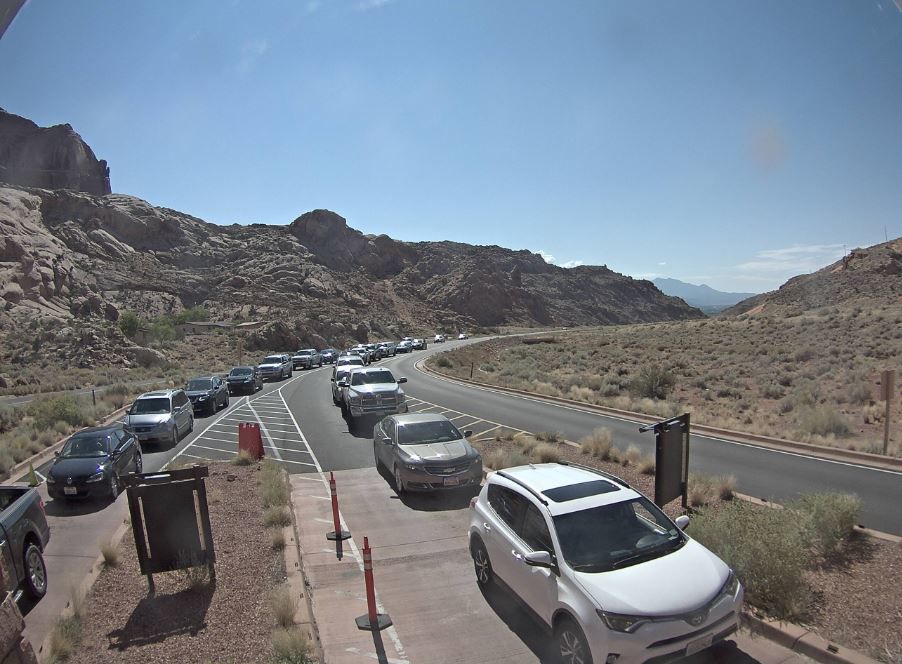Some information may be outdated.
At a special meeting on May 4, Moab City Councilmember Kalen Jones told the city council about a conversation he had last month with a ranger at Arches National Park.
“They were just relaying how demoralized the staff already were, and overwhelmed they were feeling—which is really unfortunate, given it was just the beginning of spring,” Jones said. “We’ve got a long year to go if they’re just doing triage in the parking areas.”
The remark was made during a discussion of a “timed entry system” for vehicles entering Arches National Park. Under this system, during the peak hours of the busiest times of year, visitors would have to reserve a two-hour entry window for when they could drive into the park on a certain day. Currently, the park is regularly becoming too crowded to accept more visitors, and park staff must close the entry gates until some vehicles leave.
Both the City of Moab and Grand County approved a joint letter on May 4 to the Regional Director of the National Park Service requesting a timed entry system into Arches National Park. Both bodies, along with the town of Castle Valley, sent a similar joint letter to the Deputy Director of the National Parks last year with the same request.
“Inaction is resulting in damage to park resources, fatiguing overburdened park staff, and increasing the safety risks for both staff and visitors,” the letter reads in part.
The park has seen more and more visitors over the last decade; visitation has grown 90% over the last 11 years, according to the park website, with peak season spanning March through October. All the park fans add up to long waits at the entrance, congestion in parking lots, and dense crowds at popular park attractions.
Along with diminishing the visitor experience, the traffic congestion presents an obstacle for emergency vehicles should they need to respond to an incident in the park.
To mitigate congestion, Arches has been using a parking lot capacity closure system. When popular parking lots reach a certain capacity, the entrance gates are closed until more vehicles exit. In October of 2020, the park gate had to be closed almost every day of the month under this system. [See “Arches closes gates almost every day this October,” Oct. 29 edition. -ed.] As the tourist season gets into full swing this spring, frequent closures are again becoming necessary.
“It’s not a good way, it’s not an efficient way, it’s not a smart way to manage resources,” said Councilmember Rani Derasary at the special city council meeting.
Timed entry has been used in other popular parks, such as Yosemite, parts of Glacier National Park, and Rocky Mountain National Park. Rocky Mountain announced it will be expanding the timed entry system it used last year. The system will go into effect later this month, to run through October. Permits to access either all or part of the park will have to be reserved, and two-hour entry windows will be assigned. In 2019, Rocky Mountain was the third most visited park in the country, hosting over 4.6 million people. In just the month of July, the park’s website says nearly a million people visited Rocky Mountain.
Moab elected officials pointed out that the timed entry system appears to have been a financial boon to the town of Estes Park, which neighbors Rocky Mountain, rather than the economic dent that some Moab businesses fear. When visitors know the time at which they will be able to enter the park, they don’t have to wait in a line of cars for hours; instead, they can spend that wait time at local shops and restaurants.
Crowding at the national parks is an ongoing and growing problem.
“Arches National Park has been working to manage traffic congestion in the park since at least 2006,” says the park’s website. That’s the year the park adopted its Transportation Implementation Plan. In 2011, the park initiated an Alternative Transportation System and Congestion Management Study; in 2017, the park released a proposed Traffic Congestion Management Plan, but it has since canceled the Environmental Assessment associated with that plan.
“The park has determined that additional information and analysis are needed. We are stepping back to reconsider all options for managing congestion in the park,” says the park’s website.
Over the years, officials have discussed shuttles, reservations, expanding park infrastructure, and timed entry to address overcrowding in the park. Ahead of a new planning process for traffic management, the park will continue to collect data on traffic conditions and visitor experiences, collect information on the feasibility and cost of creating a second entrance, and initiate a feasibility study on a mandatory shuttle, while remaining engaged with local stakeholders.
In the meantime, current congestion management strategies include installing parking lot attendants, messaging through various media outlets to give visitors a realistic expectation of the traffic conditions in the park, and continuing the parking lot capacity approach.
Elected officials hope that a timed entry system will be one effective tool to mitigate traffic congestion in Moab, which will need to be combined with other efforts like a public transit system, improved pedestrian and active transportation options, and improved parking.
“We always say ‘this isn’t the silver bullet,’ but in the spirit of the old spaghetti westerns… we could start saying it’s one of six silver bullets,” said Mayor Emily Neihaus of the timed entry option.
Appreciate the coverage? Help keep local news alive.
Chip in to support the Moab Sun News.





